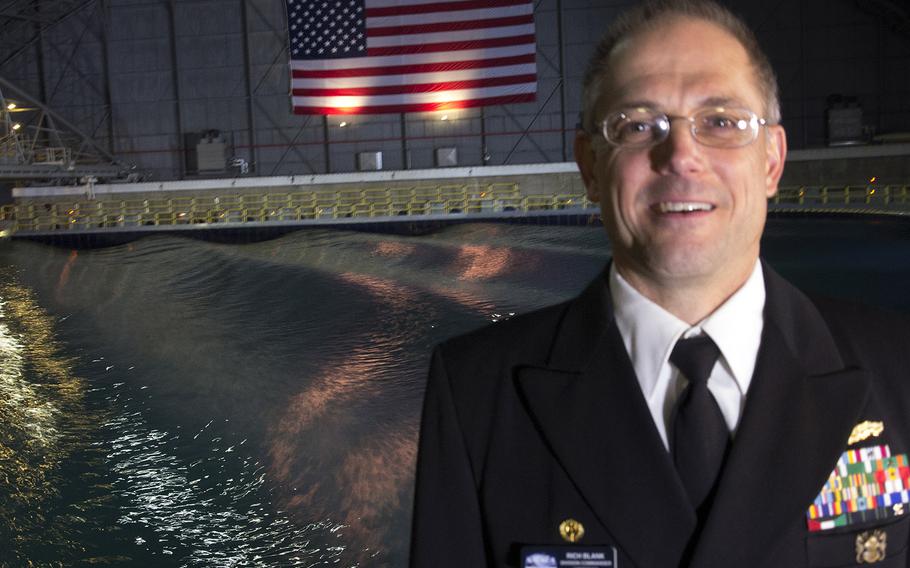
Capt. Rich Blank, commander of the Naval Surface Warfare Center's Carderock Division, stands in front of the newly-renovated Maneuvering and Seakeeping Basin (Joe Gromelski/Stars and Stripes)
WEST BETHESDA, Md. — Every sailor knows about the seven seas — and some have sailed many of them. But most probably don’t know that the U.S. Navy has created an eighth.
It is housed in Building 18 at the Naval Surface Warfare Center, Carderock Division in West Bethesda, Md. The Maneuvering and Seakeeping Facility, known as “the MASK,” was built in 1961 to model the performance of ships, platforms and moored systems in simulated sea conditions.
But a recently completed upgrade to the MASK Basin, where hydrodynamic testing occurs, represents a significant technological advancement over the decades-old system.
During the six-year renovation finished in August, the center replaced the original pneumatic wave-making system with 216 individually controlled, electro-mechanical wave boards. The 10-foot-tall, 2-foot wide yellow wave boards that line the basin function as sophisticated paddles that create waves of varying sizes and patterns.
The new wave boards “significantly enhance the capability of the facility to create a more precise wave environment, replicate waves from anywhere in the world and simulate the ocean’s most extreme conditions,” Navy Capt. Richard Blank, the commander of the center, said during a ribbon-cutting ceremony at the facility Thursday. “This new finger-style technology provides the Navy with an unprecedented capability to collect more precise test data.”
Blank said the biggest advancement is the MASK’s ability to create waves at any angle. The old system could only create 90-degree waves.
Data derived from tests provide information about the maneuverability, stability and control of surface ship and submarine models. Engineers at the facility use this information to improve the design of current and future Navy platforms.
The recent upgrade, along with the size of the facility, makes the MASK the most advanced test facility of its kind in the world, according to a fact sheet provided by the center.
“I often joke that our warfare center employees are boys with cool toys,” said Rear Adm. Lawrence Creevy, the Commander of the Naval Surface Warfare Center. “Looking at this awesome new capability, I guess I can say that this year Santa brought our boys and girls the best toy ever.”
The upgrade cost $24.7 million, according to Don Hayden, the head of the seakeeping testing branch at the facility. He said the full cost of operating the new system is yet to be determined, but it is expected to be less expensive because it is more efficient. Blank said the full spectrum of tests for a particular ship design can cost anywhere from $100,000 to millions, depending on the type of ship and the test regimen.
One example of this greater efficiency is the time required to transition from one wave formation to another. Scientists and engineers had to wait 20 minutes for the waves to die down before they could run another experiment with the old system. But new wave-dampening hardware has cut that to 30 seconds, so it takes less much time to complete the tests.
Blank believes the value of the upgrade far exceeds the cost.
“If you can design it in up front, which is what we’re trying to do here with this testing [and] modeling, you can create enormous savings in the life cycle of the overall ship class. … Whatever you can design in up front and test and prove out early on and make the modifications to that program, you’re saving the taxpayers countless dollars,” he said in an interview with Stars and Stripes. “We’re hoping that this facility will be working for the next 50 years and it will pay for itself many times over.”
MASK engineers design, build and test their own model vessels. The next ship major ship design to be tested is that of the DDG-1000, the Navy’s new guided missile destroyer. Testing is scheduled to begin in early 2014. Tests usually take several months, Blank said.
The demonstration of the new capabilities began with much fanfare as Wagner’s “Flight of the Valkyries” was blasted at the audience through speakers. Officials stood on a partial bridge hovering over the basin, which is roughly the size of a football field and holds 12 million gallons of water.
The first wave that emerged from the corner of the giant pool was only eight inches high, which Blank said was typical of most tests. But when a wave that size hits a model ship that is 1/46 the size of a normal vessel, it is roughly equivalent to a 30-foot wave hitting a Navy ship at sea.
The new system was designed by Edinburgh Designs Ltd., a Scottish firm. MAR Inc. was the prime contractor for the fabrication.
Plans call for two other wave-making facilities at the center to undergo similar modernization, but funding has yet to be approved, Hayden said.
harper.jon@stripes.com Twitter: @JHarperStripes